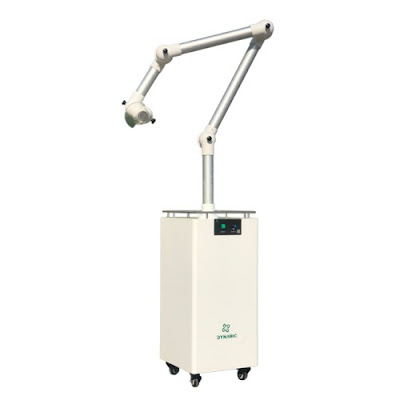The prevalence of harmful dental aerosols calls for appropriate infection control and preventive measurements in the practice to ensure the safety of both dental professionals and their patients. As soon as a patient steps into the dental clinic, the dentist and their team should make every attempt possible to ensure infection control and avoid cross-contamination of bacteria and viruses.
RUIWAN 220W RD80 Dental Extra Oral Aerosol Suction System
Gaining a clear health history for each patient, completing a thorough examination, and requiring patients to rinse with a microbial mouth rinse before treatments are all necessary best practices. When having the patient rinse prior to treatment, it is important to follow the recommended time according to the rinse. If the instructions recommend a 30-second rinse and the patient just swishes and spits within 10 seconds, for example, the benefits for the rinse are mitigated.
Protective equipment (including gloves), dental face masks that are ASTM level 3 if procedures produce aerosols, and protective eyewear should be worn at all times during procedures. Masks should cover the mouth and nose snugly, be single-use, and changed between each patient. Microbial accumulation in the waterline should be avoided by flushing it at the beginning of every day for at least 30 seconds and in between every patient. The correct positioning of a high volume suction evacuator beside the mouth and handpiece should be utilized and can minimize the production of aerosols by 90%.9.
Dynamic Extraoral Aerosol Suction Unit External Oral Suction System DS1000
In regard to the decontamination of air in the clinic, HEPA (high-efficiency particulate air) filters, ozonization, ionization, and air sterilization are four technologies targeting air quality. Some, though, are not reliable in getting completely rid of the pathogens.9 HEPA filters send air through various prefilters to assist with catching airborne particulate matter.
In regards to sterilization within the clinic, autoclaving dental handpieces sterilizes the external surfaces, and chemiclave achieves internal sterility. Handpieces should be sterilized after every patient, according to the CDC. Ammonia or enzymatic detergent with water should be used to clean suction lines at the end of every day. Using thin plastic bags to place on surfaces such as controls, handles, armrests, and handpieces within the clinic can help reduce surface contamination.
When practiced correctly, these measures can reduce the cross-contamination of infectious pathogens between people and the production of harmful dental aerosols in the clinic. However, there are further practical actions that should be taken to protect the airways of both dental professionals and their patients.
If you have any problem in choosing dental aerosol suction system, you can feel free to contact us.
https://www.oyodental.com/blog/2020/04/30/how-to-make-one-covid-19-uvc-sterilizer-box/
http://www.chinadentalsupplier.com/2020/04/30/four-reasons-why-you-should-avoid-ozone-generator-air-purifier/
RUIWAN 220W RD80 Dental Extra Oral Aerosol Suction System
Gaining a clear health history for each patient, completing a thorough examination, and requiring patients to rinse with a microbial mouth rinse before treatments are all necessary best practices. When having the patient rinse prior to treatment, it is important to follow the recommended time according to the rinse. If the instructions recommend a 30-second rinse and the patient just swishes and spits within 10 seconds, for example, the benefits for the rinse are mitigated.
Protective equipment (including gloves), dental face masks that are ASTM level 3 if procedures produce aerosols, and protective eyewear should be worn at all times during procedures. Masks should cover the mouth and nose snugly, be single-use, and changed between each patient. Microbial accumulation in the waterline should be avoided by flushing it at the beginning of every day for at least 30 seconds and in between every patient. The correct positioning of a high volume suction evacuator beside the mouth and handpiece should be utilized and can minimize the production of aerosols by 90%.9.
Dynamic Extraoral Aerosol Suction Unit External Oral Suction System DS1000
In regard to the decontamination of air in the clinic, HEPA (high-efficiency particulate air) filters, ozonization, ionization, and air sterilization are four technologies targeting air quality. Some, though, are not reliable in getting completely rid of the pathogens.9 HEPA filters send air through various prefilters to assist with catching airborne particulate matter.
In regards to sterilization within the clinic, autoclaving dental handpieces sterilizes the external surfaces, and chemiclave achieves internal sterility. Handpieces should be sterilized after every patient, according to the CDC. Ammonia or enzymatic detergent with water should be used to clean suction lines at the end of every day. Using thin plastic bags to place on surfaces such as controls, handles, armrests, and handpieces within the clinic can help reduce surface contamination.
When practiced correctly, these measures can reduce the cross-contamination of infectious pathogens between people and the production of harmful dental aerosols in the clinic. However, there are further practical actions that should be taken to protect the airways of both dental professionals and their patients.
If you have any problem in choosing dental aerosol suction system, you can feel free to contact us.
https://www.oyodental.com/blog/2020/04/30/how-to-make-one-covid-19-uvc-sterilizer-box/
http://www.chinadentalsupplier.com/2020/04/30/four-reasons-why-you-should-avoid-ozone-generator-air-purifier/


I wanted to thank you for this excellent read. we provide Best Dentist in Los Angeles at affordable prices. for more info visit our website.
ReplyDelete